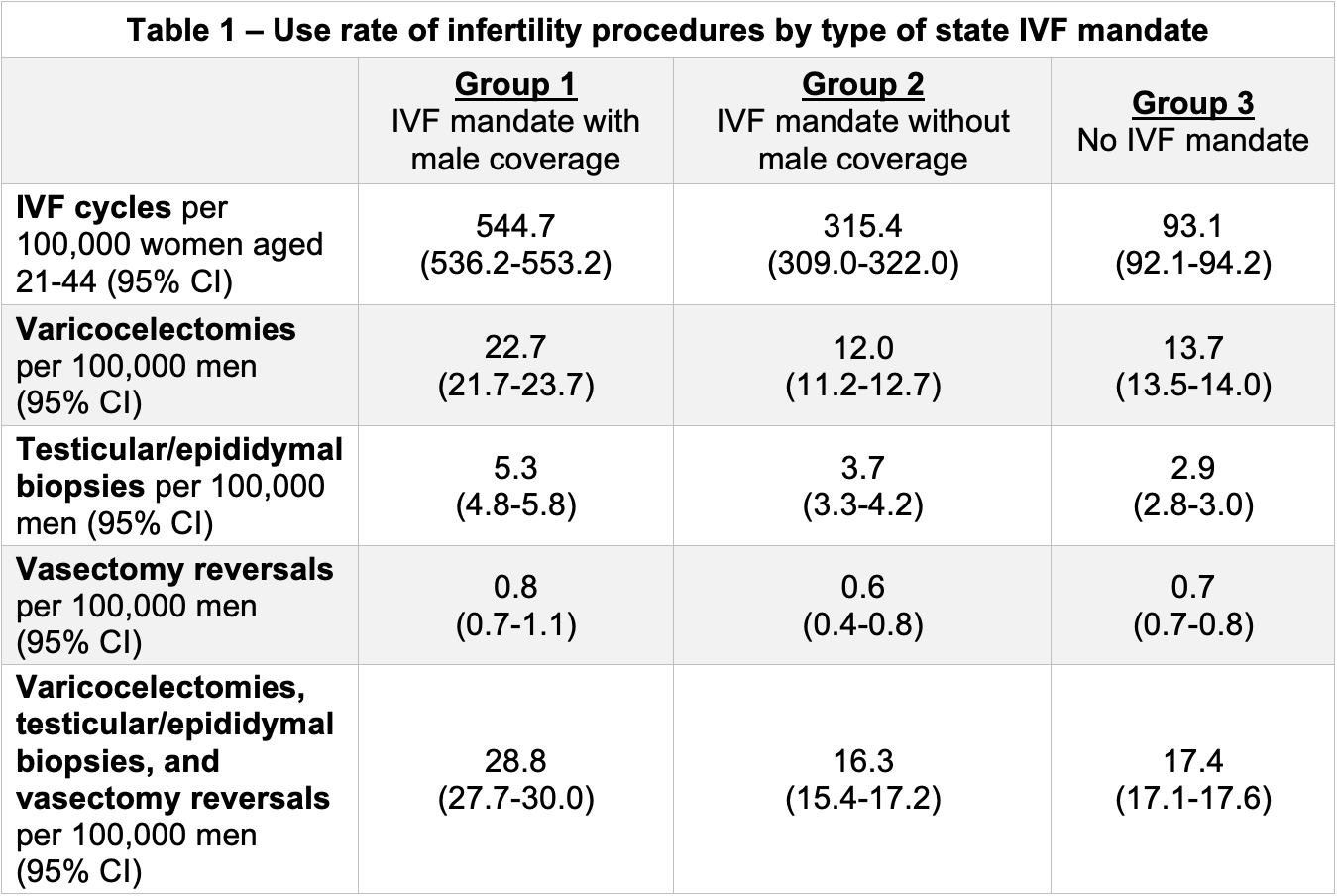Back
Introduction: By 2019, 11 states had passed laws mandating insurance coverage for infertility care, including in-vitro fertilization (IVF). These mandates vary in their coverage for male infertility care, with five states (AR, HI, IL, MD, RI) mandating IVF coverage but not coverage for male infertility care. Our objective was to evaluate the use of IVF and three common male infertility procedures (varicocelectomy, testicular/epididymal biopsy, and vasectomy reversal) in three groups of states: 1) states mandating IVF coverage and male infertility care, 2) states mandating IVF coverage but not male infertility care, and 3) states without IVF mandates.
Methods: We obtained nationwide insurance claims from over 80 million individuals from 2003 to 2019 from Optum® ClinformaticsTM Data Mart. We identified IVF cycles using the Current Procedural Terminology (CPT) code for oocyte retrieval and excluded oocyte retrievals performed for fertility preservation. We identified varicocelectomy, testicular/epididymal biopsy, and vasectomy reversal using their respective CPT codes. States were categorized into three groups: 1) states mandating IVF coverage and male infertility care (CT, MA, NJ, NY, DE 2018-19, UT 2018-19); 2) states mandating IVF coverage but not male infertility care (AR, HI, IL, MD, RI); and 3) all remaining states, including both DE and UT from 2003-2017. Within each group of states, we calculated the use rates and 95% confidence intervals (CIs) of IVF cycles per 100,000 women aged 21-44 and of varicocelectomy, testicular/epididymal biopsy, and vasectomy reversal per 100,000 men.
Results: IVF use was highest in Group 1 states and lowest in Group 3 states (Table 1). Varicocelectomy and testicular/epididymal biopsy use was 43% to 89% higher in Group 1 states than in Group 2 and 3 states. Use of vasectomy reversal—a procedure not typically covered by insurance regardless of state mandates—was only 14% higher in Group 1 states than in Group 3 states. The overall use of male infertility procedures was similar in Group 2 and 3 states.
Conclusions: There is decreased use of male infertility procedures in states whose IVF mandates do not include coverage for male infertility care. Policymakers considering new state mandates for IVF should include coverage for male infertility care to facilitate access to effective male infertility treatments. SOURCE OF
Funding: Eunice Kennedy Shriver National Institute of Child Health & Human Development - 1R01HD103603-01A1

Podium Session
Session: PD18: Infertility: Epidemiology & Evaluation II
PD18-11: Impact of state in-vitro fertilization mandates on male infertility care
Saturday, April 29, 2023
11:10 AM – 11:20 AM CST
Location: S502
- JD
James M. Dupree, IV, MD, MPH (he/him/his)
Associate Professor
University of Michigan
Podium Presenter(s)
Introduction: By 2019, 11 states had passed laws mandating insurance coverage for infertility care, including in-vitro fertilization (IVF). These mandates vary in their coverage for male infertility care, with five states (AR, HI, IL, MD, RI) mandating IVF coverage but not coverage for male infertility care. Our objective was to evaluate the use of IVF and three common male infertility procedures (varicocelectomy, testicular/epididymal biopsy, and vasectomy reversal) in three groups of states: 1) states mandating IVF coverage and male infertility care, 2) states mandating IVF coverage but not male infertility care, and 3) states without IVF mandates.
Methods: We obtained nationwide insurance claims from over 80 million individuals from 2003 to 2019 from Optum® ClinformaticsTM Data Mart. We identified IVF cycles using the Current Procedural Terminology (CPT) code for oocyte retrieval and excluded oocyte retrievals performed for fertility preservation. We identified varicocelectomy, testicular/epididymal biopsy, and vasectomy reversal using their respective CPT codes. States were categorized into three groups: 1) states mandating IVF coverage and male infertility care (CT, MA, NJ, NY, DE 2018-19, UT 2018-19); 2) states mandating IVF coverage but not male infertility care (AR, HI, IL, MD, RI); and 3) all remaining states, including both DE and UT from 2003-2017. Within each group of states, we calculated the use rates and 95% confidence intervals (CIs) of IVF cycles per 100,000 women aged 21-44 and of varicocelectomy, testicular/epididymal biopsy, and vasectomy reversal per 100,000 men.
Results: IVF use was highest in Group 1 states and lowest in Group 3 states (Table 1). Varicocelectomy and testicular/epididymal biopsy use was 43% to 89% higher in Group 1 states than in Group 2 and 3 states. Use of vasectomy reversal—a procedure not typically covered by insurance regardless of state mandates—was only 14% higher in Group 1 states than in Group 3 states. The overall use of male infertility procedures was similar in Group 2 and 3 states.
Conclusions: There is decreased use of male infertility procedures in states whose IVF mandates do not include coverage for male infertility care. Policymakers considering new state mandates for IVF should include coverage for male infertility care to facilitate access to effective male infertility treatments. SOURCE OF
Funding: Eunice Kennedy Shriver National Institute of Child Health & Human Development - 1R01HD103603-01A1

